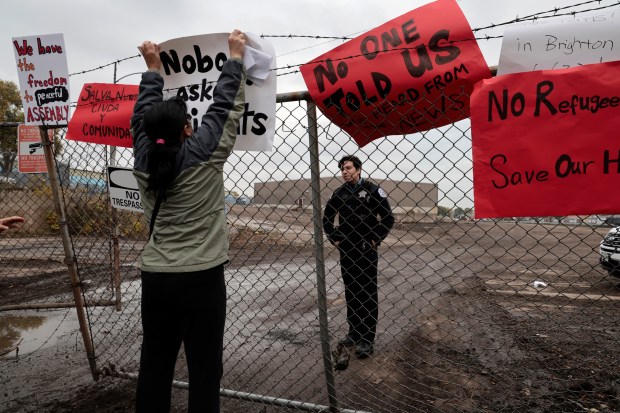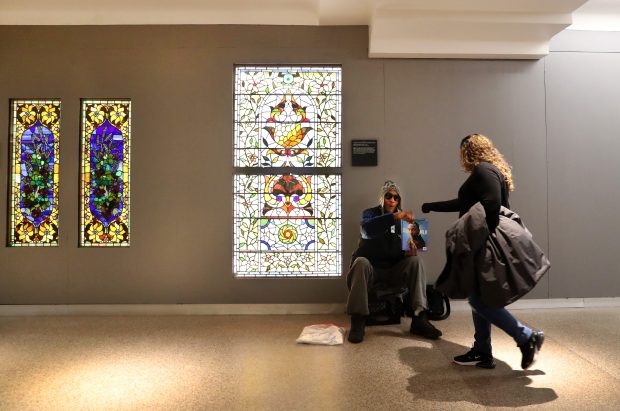As temperatures climbed into the mid-90s Tuesday afternoon, Tamala Wilson batted away flies. She sat in the shade under a canopy tent assembled in a patch of grass along Marine Drive, where she had been living for two and a half months after leaving a domestic violence shelter.
She’d stashed some ice in her cooler and filled up multiple jugs of water from the fountain in the nearby dog park. On previous scorchingly hot days this summer, Wilson had also resorted to swimming in Lake Michigan.
“The last few days have been the worst as far as heat goes (this summer),” she said.
Concerns for the homeless, elderly and those with pre-existing conditions grew this week as sweltering temperatures and heightened pollution levels continued to grip the Chicago region Tuesday, likely the “hottest day of the heat wave,” leading to hazardous conditions for vulnerable populations, according to the National Weather Service.
An excessive heat warning remains in effect until 10 p.m. in northern Illinois, as the weather service warns of a heat index — what the temperature feels like when humidity is combined with air temperature — of 110 to 115 degrees.
At O’Hare International Airport, temperatures reached 99 degrees Tuesday afternoon, breaking the record high for Aug. 27, which was originally set in 1973. The temperatures also lead Metra to implement “hot weather speed restrictions,” lowering train speed by 10 miles per hour.
Zachary Yack, a meteorologist with Chicago’s National Weather Service, said temperatures are running about 10 to 15 degrees higher than normal, which in late August is in the low to mid 80s. A little more than a year ago, on Aug. 24, 2023, Chicago experienced its first 100-degree day in more than a decade.
“This is not completely unheard of that we see this type of heat waves, but because of how mild we’ve been as of recent, this definitely feels a lot hotter than what we’ve become more accustomed to,” Yack said. “Hence it’s going to feel more oppressive to those out there that have been enjoying the pleasant weather the last several weeks.”
The weather service recommends drinking plenty of water, staying in air conditioning and limiting strenuous exercise or work to early morning or evening. Children and pets should also never be left in unattended vehicles for any length of time, as the extreme heat can cause car interiors to reach lethal temperatures in minutes.
An air quality alert also remains in effect in the Chicago metro area until midnight due to unsafe ozone levels for “sensitive groups.” Pollutants emitted by cars, industrial sources and wildfires such as those currently blazing in Canada can cause high ozone levels.
The Illinois Environmental Protection Agency recommends that children and adults, particularly those with pulmonary or respiratory disease such as asthma, should limit their outdoor activity.
Protecting ‘the most vulnerable’
The city opened cooling centers at its six community service centers operated by the Department of Family and Support Services from 9 a.m. to 5 p.m., except for the Garfield location which will keep its doors open for cooling until 8 p.m.
DFSS spokesperson Brian Berg said the agency is sending out additional outreach teams to connect homeless individuals with resources, and seniors received robocalls warning them of the excessive heat. The Salvation Army has also opened its community centers as cooling shelters, while Thresholds, a service provider for people with substance use disorders and mental illnesses, purchased and installed AC units in clients’ apartments a few months ago to help prevent emergency situations this summer.
“Seniors and the homeless are the most vulnerable, but we want to make sure everybody stays healthy and safe,” Berg said. “That’s our top priority,”
But, for Wilson, going to a city-run cooling center doesn’t feel like a feasible option. Among the dozen or so people who live in tents along Marine Drive in Uptown, none would want to risk leaving all of their belongings unattended for hours, she said.
“They gotta stay here to watch their stuff,” Wilson said. “You’re gone for any amount of time, and they know they’ll go in and take what they want.”
For Joanna Kondracki-Miro, who also lives in a tent in Uptown near the lake, the biggest concern on Tuesday was keeping her 10-year-old dog Bailey cool.
“It’s been kind of brutal, and it’s been worse for (Bailey) because she’s got a thick coat,” Kondracki-Miro said. “I’m trying to get her to a vet and to get her coat clipped. I am sweating bullets. And everybody’s kind of trying to lay low and stay cool.”
Kondracki-Miro has been living on the streets for about a year and said she’d still far prefer the hottest days of summer to the Chicago winter. She added that she had considered going to Walgreens or Target for the air conditioning – the stores being closer to her than any city-run cooling center – but didn’t want to get kicked out for loitering.
Doug Schenkelberg, executive director of the Chicago Coalition to end Homelessness, said it’s crucial for people living on the streets to know where they can go to shelter from the elements during days of extreme weather, although it’s only a temporary solution.
He added that people experiencing homelessness are usually more likely to have pre-existing health issues that are dangerously exacerbated in extreme heat.
“The big thing that we talk about is, what are we doing outside of these emergency events to minimize who’s in harm’s way to begin with?” Schenkelberg said. “It just points to the perennial need for more permanent housing so that no one is homeless to begin with, and we don’t have to worry about how extreme weather is impacting people living on the streets.”
Wilson added that she was more worried about the potential Tuesday night thunderstorms than the day’s heat itself, even as she sat sweating in a t-shirt and shorts. Pointing at the large tree above her, she said, “You got to make sure that if a branch falls, where are you going to shelter?”
Tuesday night’s thunderstorms and rain showers across northern Illinois and northwestern Indiana are forecasted to bring some relief from the high temperatures, but the weather service said they may be strong to severe with damaging winds and hail.
Temperatures are expected to gradually fall the rest of the week, according to the weather service, with some chance of storms. Wednesday’s forecast is partly sunny with a high near 79 degrees.
CPS students return to class
The afternoon heat also impacted parents who were picking their children up from school. Chicago Public Schools, whose new year started Monday, said earlier this week that it canceled all outdoor activities or moved them inside, assuring parents that all classrooms have air conditioning and will be kept at comfortable levels.
The Chicago Teachers Union has been negotiating for better cooling systems, particularly in older buildings that aren’t equipped for extreme heat.
Standing outside Swift Specialty School in Edgewater Tuesday afternoon, Dragana Perez said Aeris, her daughter who just started kindergarten, has been cool and comfortable inside. If anything, she joked that she’s the one who had to come prepared with an iced coffee.
“They beautifully inform us over email about all the plans, they try to do the activities inside,” she said. “They keep them hydrated, it’s all good.”
After school, Perez said she plans to head over the beach to cool down even more, saying it’s “amazing for kids.”





